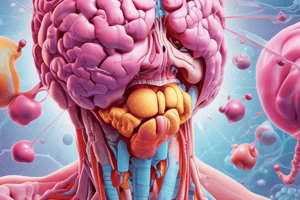Podcast
Questions and Answers
What condition is indicated by Nadir's elevated HbA1c level and symptoms of polydipsia and polyuria?
What condition is indicated by Nadir's elevated HbA1c level and symptoms of polydipsia and polyuria?
- Type 2 diabetes (correct)
- Type 1 diabetes
- Hypoglycemia
- Hyperthyroidism
Which laboratory finding is typical in a patient diagnosed with Graves' disease?
Which laboratory finding is typical in a patient diagnosed with Graves' disease?
- Elevated cortisol levels
- Increased insulin levels
- High TSH levels
- Low TSH levels (correct)
Which physical feature most closely indicates the diagnosis that Ahmad may have?
Which physical feature most closely indicates the diagnosis that Ahmad may have?
- Obesity
- Goiter
- Large hands and feet (correct)
- Skin rash
What underlying condition is likely causing the persistent symptoms in Hoor?
What underlying condition is likely causing the persistent symptoms in Hoor?
What is the most likely cause of Ahmad's elevated levels of IGF-1 and Growth Hormone?
What is the most likely cause of Ahmad's elevated levels of IGF-1 and Growth Hormone?
Flashcards
What is Type 2 diabetes?
What is Type 2 diabetes?
Type 2 diabetes is a chronic condition where the body either doesn't produce enough insulin or can't use it properly, leading to high blood sugar levels.
What is Graves' disease?
What is Graves' disease?
Graves' disease is an autoimmune disorder where the body's immune system attacks the thyroid gland, causing it to produce too much thyroid hormone (hyperthyroidism).
What is acromegaly?
What is acromegaly?
Acromegaly is a hormonal disorder caused by excessive growth hormone production by the pituitary gland. It leads to abnormal growth in hands, feet, and facial features.
What is HbA1c?
What is HbA1c?
Signup and view all the flashcards
What is IGF-1?
What is IGF-1?
Signup and view all the flashcards
Study Notes
Case 1: Type 2 Diabetes
- Nadir, a 43-year-old taxi driver, presented with a 1-month history of polydipsia and polyuria.
- He appeared obese with a BMI of 32 kg/m².
- Physical exam was unremarkable except for the BMI.
- Lab results showed a HbA1c of 9.1% (normal ≤6.5%) and fasting plasma glucose of 127 mg/dL (normal ≤100 mg/dL).
- Treatment advised included lifestyle modifications, diet therapy, regular exercise, and oral medications.
Case 2: Graves' Disease
- Hoor, a 43-year-old female, presented with a 1-year history of palpitations, fatigue, and hand tremors.
- Symptoms worsened over two months.
- Physical exam revealed a goiter, moist skin, hand tremor, and tachycardia (110 bpm).
- Lab investigations revealed low TSH levels.
Case 3: Acromegaly
- Dr. Abdullah noticed his cousin Ahmad's (35-year-old) prominent mandible, supraorbital ridges, nose bridge, large hands, and feet after 2 years.
- Ahmad was asked to undergo endocrine testing.
- Tests included serum adrenocorticotropic hormone, thyroid-stimulating hormone, prolactin, hemoglobin A1C, IGF-1, Growth Hormone, and parathyroid hormone.
- Only serum IGF-1 and GH levels were abnormal.
- Further tests confirmed a pituitary adenoma diagnosis.
Studying That Suits You
Use AI to generate personalized quizzes and flashcards to suit your learning preferences.




